Huan Chen
Hyperspectral Remote Sensing Images Salient Object Detection: The First Benchmark Dataset and Baseline
Apr 03, 2025Abstract:The objective of hyperspectral remote sensing image salient object detection (HRSI-SOD) is to identify objects or regions that exhibit distinct spectrum contrasts with the background. This area holds significant promise for practical applications; however, progress has been limited by a notable scarcity of dedicated datasets and methodologies. To bridge this gap and stimulate further research, we introduce the first HRSI-SOD dataset, termed HRSSD, which includes 704 hyperspectral images and 5327 pixel-level annotated salient objects. The HRSSD dataset poses substantial challenges for salient object detection algorithms due to large scale variation, diverse foreground-background relations, and multi-salient objects. Additionally, we propose an innovative and efficient baseline model for HRSI-SOD, termed the Deep Spectral Saliency Network (DSSN). The core of DSSN is the Cross-level Saliency Assessment Block, which performs pixel-wise attention and evaluates the contributions of multi-scale similarity maps at each spatial location, effectively reducing erroneous responses in cluttered regions and emphasizes salient regions across scales. Additionally, the High-resolution Fusion Module combines bottom-up fusion strategy and learned spatial upsampling to leverage the strengths of multi-scale saliency maps, ensuring accurate localization of small objects. Experiments on the HRSSD dataset robustly validate the superiority of DSSN, underscoring the critical need for specialized datasets and methodologies in this domain. Further evaluations on the HSOD-BIT and HS-SOD datasets demonstrate the generalizability of the proposed method. The dataset and source code are publicly available at https://github.com/laprf/HRSSD.
Mixed-granularity Implicit Representation for Continuous Hyperspectral Compressive Reconstruction
Mar 17, 2025Abstract:Hyperspectral Images (HSIs) are crucial across numerous fields but are hindered by the long acquisition times associated with traditional spectrometers. The Coded Aperture Snapshot Spectral Imaging (CASSI) system mitigates this issue through a compression technique that accelerates the acquisition process. However, reconstructing HSIs from compressed data presents challenges due to fixed spatial and spectral resolution constraints. This study introduces a novel method using implicit neural representation for continuous hyperspectral image reconstruction. We propose the Mixed Granularity Implicit Representation (MGIR) framework, which includes a Hierarchical Spectral-Spatial Implicit Encoder for efficient multi-scale implicit feature extraction. This is complemented by a Mixed-Granularity Local Feature Aggregator that adaptively integrates local features across scales, combined with a decoder that merges coordinate information for precise reconstruction. By leveraging implicit neural representations, the MGIR framework enables reconstruction at any desired spatial-spectral resolution, significantly enhancing the flexibility and adaptability of the CASSI system. Extensive experimental evaluations confirm that our model produces reconstructed images at arbitrary resolutions and matches state-of-the-art methods across varying spectral-spatial compression ratios. The code will be released at https://github.com/chh11/MGIR.
Spectrum-oriented Point-supervised Saliency Detector for Hyperspectral Images
Dec 24, 2024



Abstract:Hyperspectral salient object detection (HSOD) aims to extract targets or regions with significantly different spectra from hyperspectral images. While existing deep learning-based methods can achieve good detection results, they generally necessitate pixel-level annotations, which are notably challenging to acquire for hyperspectral images. To address this issue, we introduce point supervision into HSOD, and incorporate Spectral Saliency, derived from conventional HSOD methods, as a pivotal spectral representation within the framework. This integration leads to the development of a novel Spectrum-oriented Point-supervised Saliency Detector (SPSD). Specifically, we propose a novel pipeline, specifically designed for HSIs, to generate pseudo-labels, effectively mitigating the performance decline associated with point supervision strategy. Additionally, Spectral Saliency is employed to counteract information loss during model supervision and saliency refinement, thereby maintaining the structural integrity and edge accuracy of the detected objects. Furthermore, we introduce a Spectrum-transformed Spatial Gate to focus more precisely on salient regions while reducing feature redundancy. We have carried out comprehensive experiments on both HSOD-BIT and HS-SOD datasets to validate the efficacy of our proposed method, using mean absolute error (MAE), E-measure, F-measure, Area Under Curve, and Cross Correlation as evaluation metrics. For instance, on the HSOD-BIT dataset, our SPSD achieves a MAE of 0.031 and an F-measure of 0.878. Thorough ablation studies have substantiated the effectiveness of each individual module and provided insights into the model's working mechanism. Further evaluations on RGB-thermal salient object detection datasets highlight the versatility of our approach.
Modeling Layout Reading Order as Ordering Relations for Visually-rich Document Understanding
Sep 29, 2024Abstract:Modeling and leveraging layout reading order in visually-rich documents (VrDs) is critical in document intelligence as it captures the rich structure semantics within documents. Previous works typically formulated layout reading order as a permutation of layout elements, i.e. a sequence containing all the layout elements. However, we argue that this formulation does not adequately convey the complete reading order information in the layout, which may potentially lead to performance decline in downstream VrD tasks. To address this issue, we propose to model the layout reading order as ordering relations over the set of layout elements, which have sufficient expressive capability for the complete reading order information. To enable empirical evaluation on methods towards the improved form of reading order prediction (ROP), we establish a comprehensive benchmark dataset including the reading order annotation as relations over layout elements, together with a relation-extraction-based method that outperforms previous methods. Moreover, to highlight the practical benefits of introducing the improved form of layout reading order, we propose a reading-order-relation-enhancing pipeline to improve model performance on any arbitrary VrD task by introducing additional reading order relation inputs. Comprehensive results demonstrate that the pipeline generally benefits downstream VrD tasks: (1) with utilizing the reading order relation information, the enhanced downstream models achieve SOTA results on both two task settings of the targeted dataset; (2) with utilizing the pseudo reading order information generated by the proposed ROP model, the performance of the enhanced models has improved across all three models and eight cross-domain VrD-IE/QA task settings without targeted optimization.
Context-Driven Index Trimming: A Data Quality Perspective to Enhancing Precision of RALMs
Aug 10, 2024



Abstract:Retrieval-Augmented Large Language Models (RALMs) have made significant strides in enhancing the accuracy of generated responses.However, existing research often overlooks the data quality issues within retrieval results, often caused by inaccurate existing vector-distance-based retrieval methods.We propose to boost the precision of RALMs' answers from a data quality perspective through the Context-Driven Index Trimming (CDIT) framework, where Context Matching Dependencies (CMDs) are employed as logical data quality rules to capture and regulate the consistency between retrieved contexts.Based on the semantic comprehension capabilities of Large Language Models (LLMs), CDIT can effectively identify and discard retrieval results that are inconsistent with the query context and further modify indexes in the database, thereby improving answer quality.Experiments demonstrate on challenging question-answering tasks.Also, the flexibility of CDIT is verified through its compatibility with various language models and indexing methods, which offers a promising approach to bolster RALMs' data quality and retrieval precision jointly.
UNER: A Unified Prediction Head for Named Entity Recognition in Visually-rich Documents
Aug 02, 2024


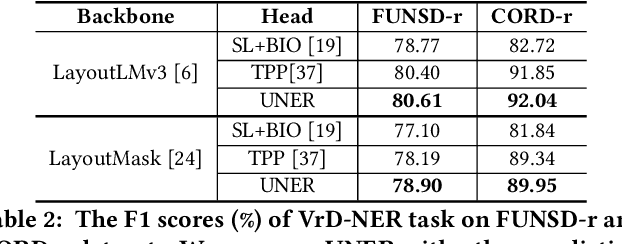
Abstract:The recognition of named entities in visually-rich documents (VrD-NER) plays a critical role in various real-world scenarios and applications. However, the research in VrD-NER faces three major challenges: complex document layouts, incorrect reading orders, and unsuitable task formulations. To address these challenges, we propose a query-aware entity extraction head, namely UNER, to collaborate with existing multi-modal document transformers to develop more robust VrD-NER models. The UNER head considers the VrD-NER task as a combination of sequence labeling and reading order prediction, effectively addressing the issues of discontinuous entities in documents. Experimental evaluations on diverse datasets demonstrate the effectiveness of UNER in improving entity extraction performance. Moreover, the UNER head enables a supervised pre-training stage on various VrD-NER datasets to enhance the document transformer backbones and exhibits substantial knowledge transfer from the pre-training stage to the fine-tuning stage. By incorporating universal layout understanding, a pre-trained UNER-based model demonstrates significant advantages in few-shot and cross-linguistic scenarios and exhibits zero-shot entity extraction abilities.
Content-driven Magnitude-Derivative Spectrum Complementary Learning for Hyperspectral Image Classification
Jul 26, 2024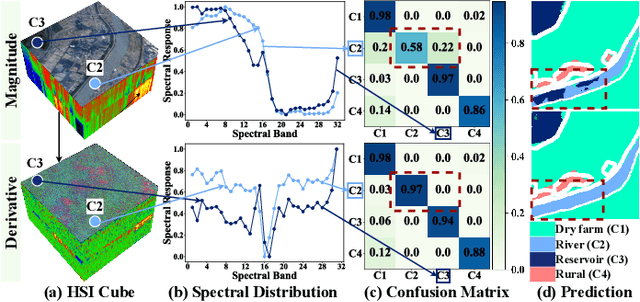
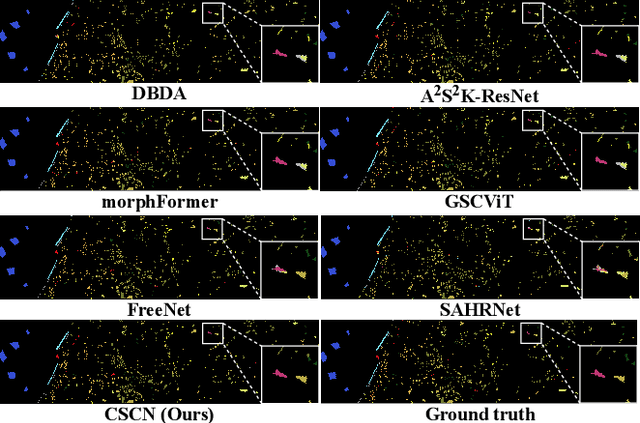
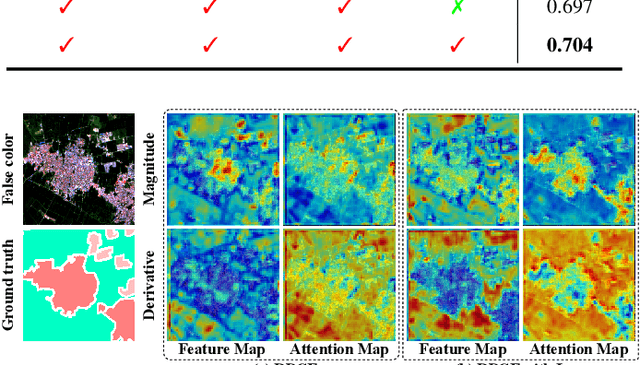

Abstract:Extracting discriminative information from complex spectral details in hyperspectral image (HSI) for HSI classification is pivotal. While current prevailing methods rely on spectral magnitude features, they could cause confusion in certain classes, resulting in misclassification and decreased accuracy. We find that the derivative spectrum proves more adept at capturing concealed information, thereby offering a distinct advantage in separating these confusion classes. Leveraging the complementarity between spectral magnitude and derivative features, we propose a Content-driven Spectrum Complementary Network based on Magnitude-Derivative Dual Encoder, employing these two features as combined inputs. To fully utilize their complementary information, we raise a Content-adaptive Point-wise Fusion Module, enabling adaptive fusion of dual-encoder features in a point-wise selective manner, contingent upon feature representation. To preserve a rich source of complementary information while extracting more distinguishable features, we introduce a Hybrid Disparity-enhancing Loss that enhances the differential expression of the features from the two branches and increases the inter-class distance. As a result, our method achieves state-of-the-art results on the extensive WHU-OHS dataset and eight other benchmark datasets.
Dual-stage Hyperspectral Image Classification Model with Spectral Supertoken
Jul 10, 2024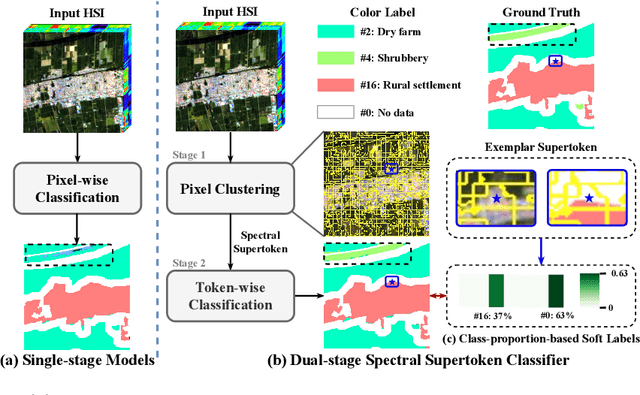

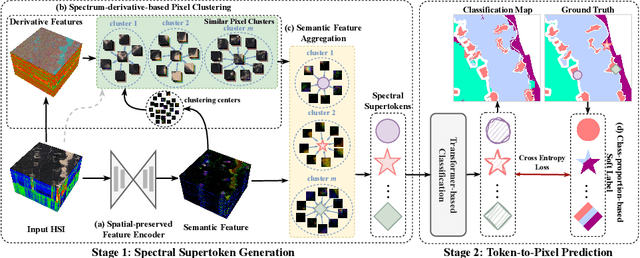
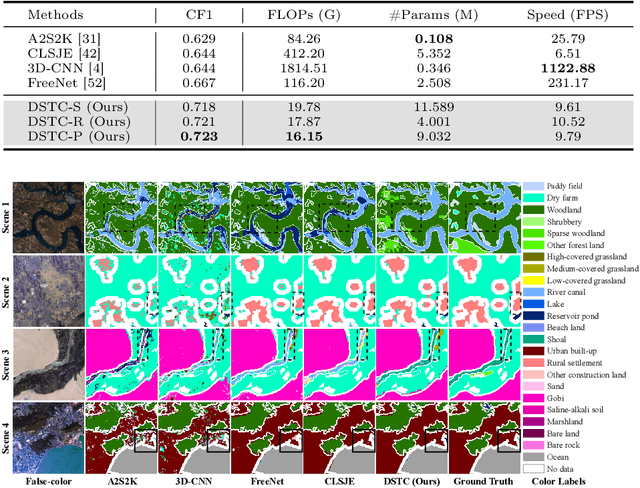
Abstract:Hyperspectral image classification, a task that assigns pre-defined classes to each pixel in a hyperspectral image of remote sensing scenes, often faces challenges due to the neglect of correlations between spectrally similar pixels. This oversight can lead to inaccurate edge definitions and difficulties in managing minor spectral variations in contiguous areas. To address these issues, we introduce the novel Dual-stage Spectral Supertoken Classifier (DSTC), inspired by superpixel concepts. DSTC employs spectrum-derivative-based pixel clustering to group pixels with similar spectral characteristics into spectral supertokens. By projecting the classification of these tokens onto the image space, we achieve pixel-level results that maintain regional classification consistency and precise boundary. Moreover, recognizing the diversity within tokens, we propose a class-proportion-based soft label. This label adaptively assigns weights to different categories based on their prevalence, effectively managing data distribution imbalances and enhancing classification performance. Comprehensive experiments on WHU-OHS, IP, KSC, and UP datasets corroborate the robust classification capabilities of DSTC and the effectiveness of its individual components. Code will be publicly available at https://github.com/laprf/DSTC.
Spectral-wise Implicit Neural Representation for Hyperspectral Image Reconstruction
Dec 02, 2023Abstract:Coded Aperture Snapshot Spectral Imaging (CASSI) reconstruction aims to recover the 3D spatial-spectral signal from 2D measurement. Existing methods for reconstructing Hyperspectral Image (HSI) typically involve learning mappings from a 2D compressed image to a predetermined set of discrete spectral bands. However, this approach overlooks the inherent continuity of the spectral information. In this study, we propose an innovative method called Spectral-wise Implicit Neural Representation (SINR) as a pioneering step toward addressing this limitation. SINR introduces a continuous spectral amplification process for HSI reconstruction, enabling spectral super-resolution with customizable magnification factors. To achieve this, we leverage the concept of implicit neural representation. Specifically, our approach introduces a spectral-wise attention mechanism that treats individual channels as distinct tokens, thereby capturing global spectral dependencies. Additionally, our approach incorporates two components, namely a Fourier coordinate encoder and a spectral scale factor module. The Fourier coordinate encoder enhances the SINR's ability to emphasize high-frequency components, while the spectral scale factor module guides the SINR to adapt to the variable number of spectral channels. Notably, the SINR framework enhances the flexibility of CASSI reconstruction by accommodating an unlimited number of spectral bands in the desired output. Extensive experiments demonstrate that our SINR outperforms baseline methods. By enabling continuous reconstruction within the CASSI framework, we take the initial stride toward integrating implicit neural representation into the field.
Spectrum-driven Mixed-frequency Network for Hyperspectral Salient Object Detection
Dec 02, 2023



Abstract:Hyperspectral salient object detection (HSOD) aims to detect spectrally salient objects in hyperspectral images (HSIs). However, existing methods inadequately utilize spectral information by either converting HSIs into false-color images or converging neural networks with clustering. We propose a novel approach that fully leverages the spectral characteristics by extracting two distinct frequency components from the spectrum: low-frequency Spectral Saliency and high-frequency Spectral Edge. The Spectral Saliency approximates the region of salient objects, while the Spectral Edge captures edge information of salient objects. These two complementary components, crucial for HSOD, are derived by computing from the inter-layer spectral angular distance of the Gaussian pyramid and the intra-neighborhood spectral angular gradients, respectively. To effectively utilize this dual-frequency information, we introduce a novel lightweight Spectrum-driven Mixed-frequency Network (SMN). SMN incorporates two parameter-free plug-and-play operators, namely Spectral Saliency Generator and Spectral Edge Operator, to extract the Spectral Saliency and Spectral Edge components from the input HSI independently. Subsequently, the Mixed-frequency Attention module, comprised of two frequency-dependent heads, intelligently combines the embedded features of edge and saliency information, resulting in a mixed-frequency feature representation. Furthermore, a saliency-edge-aware decoder progressively scales up the mixed-frequency feature while preserving rich detail and saliency information for accurate salient object prediction. Extensive experiments conducted on the HS-SOD benchmark and our custom dataset HSOD-BIT demonstrate that our SMN outperforms state-of-the-art methods regarding HSOD performance. Code and dataset will be available at https://github.com/laprf/SMN.
 Add to Chrome
Add to Chrome Add to Firefox
Add to Firefox Add to Edge
Add to Edge